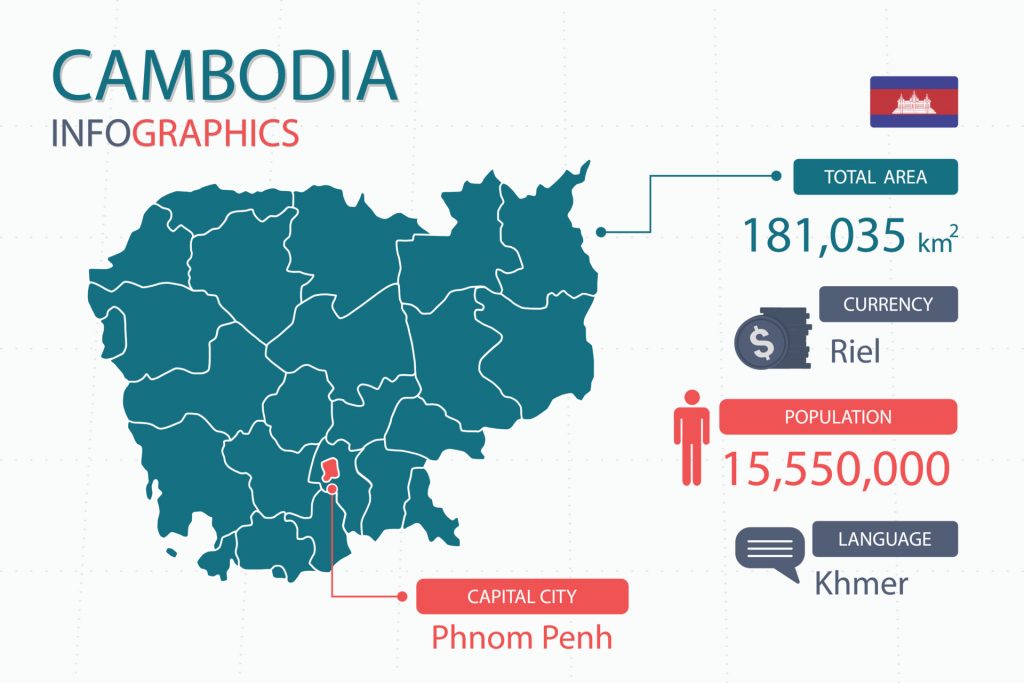The origins of the Khmer Language
Khmer language, also known as Cambodian, is the official language of Cambodia. Khmer language has approximately 16 million speakers and it’s spoken mostly in Cambodia.
Khmer is also spoken in other locales such as in Vietnam (due to the Khmer Krom population) and in Thailand due to Khmer Surin populations native to the Thai provinces of Surin, Sisaket, Buriram, and Roi Et. Khmer is also spoken in many Cambodian communities abroad due to the civil war during which many refugees fled the country. It is unique among the languages in the region, because unlike the languages of the region that surround Cambodia, notably, Vietnamese, Burmese, Lao, and Thai, Khmer is not a tonal language.
The Khmer speaking locales are using the same Khmer writing system so all the regions mentioned above will be able to read the Khmer text.
It’s worth to note that in Khmer just like in Thai, numerals can be written either their own writing system or by using the Arabic numerals used in the Western countries.
Khmer is known as a Austroasiatic language, which includes languages such as Vietnamese, Mon, and Munda. In addition to Vietnamese, it also has been heavily influenced by Thai, Lao, Cham, and varieties of Chinese. This is due to the long-term cultural contact as a result of geographical proximity. Due to French colonialism and recent English globalization, it has also absorbed vocabulary from these respective languages as well. All our Khmer translators can provide professional translation Khmer to English as well as English to Khmer.

Khmer is written using the Khmer script, an abugida. This sort of script has consonants with an inherent vowel, and a mark attached to the consonant to signify any vowel changes. This is unlike Western scripts, where vowels and consonants are separate letters. The Khmer script is a descendent of the Brahmi script, one that was used in southern India and Southeast Asia during the 5th and 6th centuries. It is written from left to right and there are generally no spaces between words in the same sentence. Modern Khmer uses 33 consonant characters. In addition there are independent vowels, dependent vowels, and other marks, making it the script with the most amount of symbols in the world after Chinese. All together, they work to form the Khmer script.
The Cambodian Language structure and grammar may be considered less complex compared to its European linguistic counterparts. This is perhaps due to the fact that neither nouns or verbs inflect. That is, there is not present tense or past tense in the verbal sense. Rather, time is signified by context and time words such as ‘yesterday’ or ‘tomorrow’. Nouns also do not morph for case. However, it is similar to languages like English because the word order is subject-verb-object.
According to scholars and Khmer translators providing Translation in Khmer, the history of the Khmer language can be divided into five periods. However, not much is known about earlier periods due to a lack of records. The period before 600 CE is known as Pre-Khmer, presumably when the language first started developing. Between 600- 800, the period known as Pre-Angkorian Old Khmer can be identified by linguists, even though not much is known about this period as well. For this era, there are few records of old words and phrases from Sanskrit texts of that time period. However, Angkorian Old Khmer, existing from the 9th century to the 13th century, is well-studied. At this time, it was the language of the Khmer Empire and thus was a very influential language in terms of government, education, and cultural significance.
At the end of Khmer Empire, there was a period of change in all aspects of the language, especially in terms of vocabulary. The period between the 14th and 18th period is known as Middle Khmer, and during this time, there were many words borrowed from Thai, Lao, Vietnamese, as well as other languages. The language evolved into modern Khmer from the beginning of the 1800s to the present.
During the period when modern Khmer was emerging, Cambodia was subjected to the influence of French colonialism. Cambodia eventually became fully integrated into French Indochina. During French colonial rule, the French language became official languages of education, trade and commerce, and government administration. There was also a formation of a French-speaking aristocracy. Due to the status of the French language, French vocabulary seeped into the Khmer language, especially in terms of scientific and technological fields of study. More recently, English has also had an impact on the Khmer language due to the globalization of English, especially in terms of education and business.
A special characteristic of Khmer that distinguishes it from more well-known languages is represented by the system of social registers, where a speaker’s and listener’s social position is reflected in the use of pronouns and vocabulary. For example, when speaking to one’s friends, one will use different personal pronouns, verbs, and other vocabulary items compared to when one is speaking to elders, and this changes yet again when one speaks to monks, royalty, and in other various situations. Such social aspects are especially prevalent in the system of personal pronouns where there are a large number of personal pronouns to express concepts like I/me, you, and he/she.
In current times, 72% of the population in Cambodia is literate in Khmer. While Khmer dominates the social sphere in Cambodia and is also a primary language of education, English and French also play a vital role in a variety of fields such as higher education and business due to the former’s residual influence and the latter’s global prestige. Thus, terminology relating to either business or some sciences that does not exist in Khmer are borrowed from these two languages. While there is a standard version of Khmer based on Central Khmer, there are large dialectal differences between Central Khmer, Northern Khmer, Khmer in the capital, and other regions. Sometimes, these differences are so large, they are not mutually intelligible. Moreover, some dialects of Northern Khmer are also written using the Thai script as these populations of Khmer speakers resides in parts of Thailand. For a language that covers such a relatively small area of the globe, it displays quite a range of both oral and written characteristics.
VEQTA can provide you with a perfect Khmer translator for your Khmer translation, English to Khmer translation and Khmer to english translation for the your targeted locale. Our translations to Khmer are created with your target audience in mind to meet your expectations.
If you need to translate Khmer – Get in touch today!
A dedicated team of Khmer translators who combines Experience, Specialized Subject Matter Expertise with best Translation Practices to deliver quality second to none.
Khmer Document Translation
Khmer Legal Translation
Khmer I.T Translation
Khmer Health & Fitness Translation
Khmer Medical Translation
Khmer Marketing Translation
Khmer Financial & Accounting Translation
Khmer Tourism & Travel Translation


